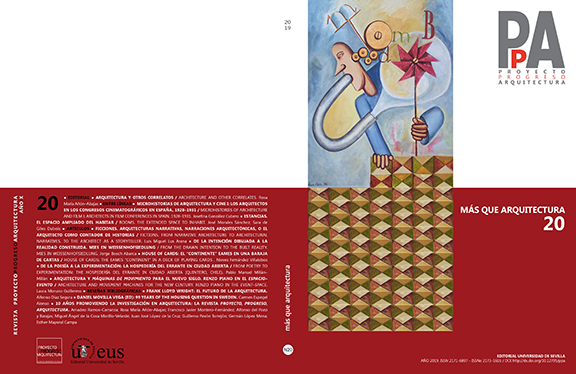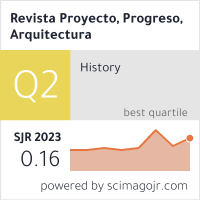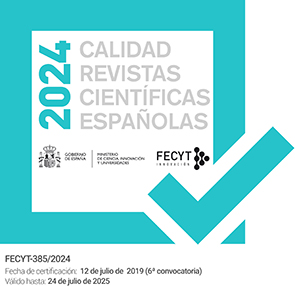DE LA INTENCIÓN DIBUJADA A LA REALIDAD CONSTRUIDA. MIES EN WEISSENHOFSIEDLUNG / FROM THE DRAWN INTENTION TO THE BUILT REALITY. MIES IN WEISSENHOFSIEDLUNG
DOI:
https://doi.org/10.12795/ppa.2019.i20.04Palabras clave:
Mies van der Rohe, Weissenhofsiedlung, nuevas formas de habitar, vivienda flexible / new ways of living, flexible housingResumen
RESUMEN: Mies van der Rohe es ya un arquitecto de prestigio internacional cuando asume la dirección de la Bauhaus en 1930. A este reconocimiento contribuyó, en gran medida, su intervención como director intelectual y artístico en la exposición de modelos de vivienda construida en el establecimiento del Weissenhof de Stuttgart en 1927, considerada como el primer momento en que la arquitectura moderna se expresa de una manera conjunta, internacional y coherente. Su aportación edilicia a la muestra, el bloque lineal de vivienda de alquiler, se incluye en todos los manuales de la historia de la arquitectura, pero en pocos lugares se destacan las diferencias evidentes entre las intenciones del autor, recogidas en los abundantes dibujos del proyecto, y la realidad construida que podemos contemplar en Stuttgart. Tras la investigación principal del proyecto en torno a una incipiente idea de flexibilidad, aún hoy vigente, otros aspectos arquitectónicos de la propuesta quedaron finalmente relegados. Aspectos formales que, en un análisis detenido de la obra, resultan extraños y que solo se entienden desde la comprensión de un proceso apresurado que parece haber obligado a ciertas renuncias. Sobre esta hipótesis de una imperfección asumida se aborda en este artículo una revisión de la propuesta de Mies en Weissenhofsiedlung.
SUMMARY Mies van der Rohe is already an architect of international prestige when he became the director of Bauhaus in 1930. A contributing factor of this recognition was, to a great extent, his intervention as intellectual and artistic director in the exhibit of models of built houses in the Weissenhof settlement of Stuttgart in 1927, considered as the first moment in which modern architecture is expressed in a joint, international and coherent way. His built contribution to the exhibition, the linear block of rental housing is included in all the history of architecture manuals. However, very few places highlight the clear differences between the author’s intentions, gathered in numerous drawings of the project and the built reality that can be contemplated in Stuttgart. Behind the main research of the project centred around an emerging idea of flexibility, still prevailing today, other architectural aspects of the proposal were finally relegated. Formal aspects that, in an in-depth analysis of the project, seem odd and are only understood from a comprehension of a hurried process that seemed to have forced certain renunciations. Relating to this hypothesis of an assumed imperfection, this article addresses a review of Mies’ proposal in Weissenhofsiedlung.
Descargas
Citas
ALTÉS BUSTELO, José. La casa con patio en Mies van der Rohe. En: Proyecto, Progreso, Arquitectura. Forma y Construcción en Arquitectura [en línea]. Sevilla: Editorial Universidad de Sevilla, mayo 2013, n.º 8, pp. 42-57 [consulta: 25-02-2019]. ISSN 2173-1616. Disponible en: https://revistascientificas.us.es/index.php/ppa/article/view/56/61. DOI: http://dx.doi.org/10.12795/ppa.2013.i8.03.
AYMONINO, Carlo. La vivienda racional : Ponencias de los congresos CIAM 1929/1930. Barcelona: Gustavo Gili, 1973. ISBN 842520755X.
CURTIS, William J. R. La arquitectura moderna desde 1900. London: Phaidon, 2006. ISBN 9780714898506; 0714898503.
DREXLER, Arthur; MIES VAN DER ROHE, Ludwig; SCHULZE, Franz. The Mies van der Rohe archive: 1910-1937. Nueva York: Garland, 1986. ISBN 0824040287.
Glasraum in der Gewerbehalle auf der Werkbundausstellung, “Die Wohnung” Stuttgart 1927. En Die Form: Zeitschrift für gestaltende Arbeit [en línea]. 1928, n.o 3, pp. 114-117 [consulta: 01.10.2018]. Disponible en: https://digi.ub.uni-heidelberg.de/diglit/form1928/0124/text_ocr
HILBERSEIMER, Ludwig. La arquitectura de la gran ciudad de Ludwig Hilberseimer. Barcelona: Gustavo Gili, 1979. ISBN 8425209498.
KIRSCH, Karin. Briefe zur Weissenhofsiedlung. Stuttgart: Deutsche Verlags-Anstalt, 1997. ISBN 3421031282.
LIZONDO SEVILLA, Laura et al. La idea materializada en el espacio construido. La muestra “Die Wohnung unserer Zeit” de Mies van der Rohe. En: Proyecto, Progreso, Arquitectura. Forma y Construcción en Arquitectura [en línea]. Sevilla: Editorial Universidad de Sevilla, mayo 2013, n.º 8, pp. 28-41 [consulta: 25-02-2019]. ISSN 2173-1616. Disponible en: https://revistascientificas.us.es/index.php/ppa/article/view/55/60. DOI: http://dx.doi.org/10.12795/ppa.2013.i8.02.
MAY, Ernst. Fünf Jahre Wohnungsbautätigkeit in Frankfurt am Main. En: Das Neue Frankfurt [en línea]. 1930, vol. 4, n.º 2, 3, pp. 21-70. Disponible en: http://digi.ub.uni-heidelberg.de/diglit/neue_frankfurt1930/0033?sid=b1e1d835fd13174573c94ac020dee246
MIES VAN DER ROHE, Ludwig; DEUTSCHER WERKBUND. Bau und Wohnung die Bauten der Weissenhofsiedlung in Stuttgart errichtet 1927 nach Vorschlägen des Deutschen Werkbundes im Auftrag der Stadt Stuttgart und im Rahmen der Werkbundausstellung “Die Wohnung”. Stuttgart: Wedekind, 1927.
MUCH, F. J. (ed.); MUCH, F. J.; KLOTZ, H.; DEBUS-STEINBERG, A. Amtlicher Katalog der Werkbund-Ausstellung “Die Wohnung”, Stuttgart 1927 (Schriftenreihe Weissenhof). Stuttgarter Gesellschaft für Kunst und Denkmalpflege. Stuttgart: [s. n.], 1998. ISBN 3-926168-10-2.
NEUMEYER, Fritz. Mies van der Rohe : la palabra sin artificio, reflexiones sobre arquitectura 1922-1968. Madrid: El Croquis, 1995. ISBN 8488386087.
POMMER, Richard; OTTO, Christian F. Weissenhof 1927 and the modern movement in architecture. Chicago: University of Chicago, 1991. ISBN 0226675157.
Werkbund-Ausstellung: Die Wohnung: Stuttgart, Juli-September 1927. En Die Form: Zeitschrift für gestaltende Arbeit [en línea]. 1927, n.o 1-2 [consulta: 01.10.2018], pp. 24-25 Disponible en: https://digi.ub.uni-heidelberg.de/diglit/form1927/0032/image
Descargas
Publicado
Cómo citar
Número
Sección
Licencia
Las ediciones impresa y electrónica de esta Revista son editadas por el Secretariado de Publicaciones de la Universidad de Sevilla, siendo necesario citar la procedencia en cualquier reproducción parcial o total.
Salvo indicación contraria, todos los contenidos de la edición electrónica se distribuyen bajo una licencia de uso y distribución “Creative Commons Atribución-NoComercial-SinDerivar 4.0 Internacional” ![]() . Puede consultar desde aquí la versión informativa y el texto legal de la licencia. Esta circunstancia ha de hacerse constar expresamente de esta forma cuando sea necesario.
. Puede consultar desde aquí la versión informativa y el texto legal de la licencia. Esta circunstancia ha de hacerse constar expresamente de esta forma cuando sea necesario.
Los autores/as que publiquen en esta revista aceptan las siguientes condiciones:
- Los autores/as conservan los derechos de autor y ceden a la revista el derecho de la primera publicación, con el trabajo registrado con la licencia de atribución de Creative Commons, que permite a terceros utilizar lo publicado siempre que mencionen la autoría del trabajo y a la primera publicación en esta revista.
- Los autores/as pueden realizar otros acuerdos contractuales independientes y adicionales para la distribución no exclusiva de la versión del artículo publicado en esta revista (p. ej., incluirlo en un repositorio institucional o publicarlo en un libro) siempre que indiquen claramente que el trabajo se publicó por primera vez en esta revista.
- Se permite y recomienda a los autores/as a publicar su trabajo en Internet (por ejemplo en páginas institucionales o personales) antes y durante el proceso de revisión y publicación, ya que puede conducir a intercambios productivos y a una mayor y más rápida difusión del trabajo publicado (vea The Effect of Open Access).









